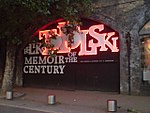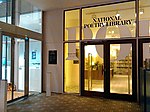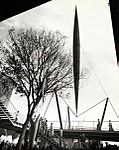Shell Centre

The Shell Centre, in London, is the global headquarters of oil major Shell plc. It is located on Belvedere Road in the London Borough of Lambeth. It is a prominent feature on the South Bank of the River Thames near County Hall, and now forms the backdrop to the London Eye. The original Shell Centre comprised the tower building and three now demolished adjoining nine storey wings (collectively formerly known as the "Upstream Building"). The original development also included a separate building known as the "Downstream Building", which was separated from the Upstream Building by the railway viaduct between Charing Cross and Waterloo East. The Downstream Building was disposed of by Shell in the 1990s, and is now a block of residential apartments known as the White House, and has been heightened by a storey.
Excerpt from the Wikipedia article Shell Centre (License: CC BY-SA 3.0, Authors, Images).Shell Centre
Belvedere Road, London Lambeth (London Borough of Lambeth)
Geographical coordinates (GPS) Address External links Nearby Places Show on map
Geographical coordinates (GPS)
| Latitude | Longitude |
|---|---|
| N 51.503833333333 ° | E -0.11688888888889 ° |
Address
Shell Centre (Shell Centre)
Belvedere Road
SE1 7NA London, Lambeth (London Borough of Lambeth)
England, United Kingdom
Open on Google Maps










